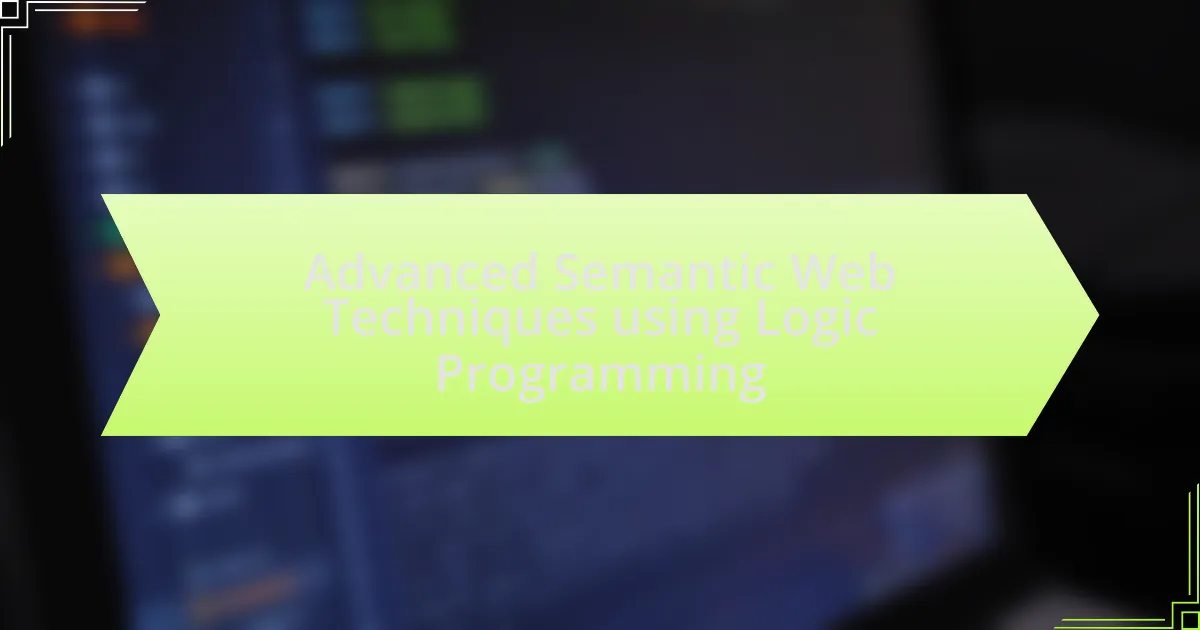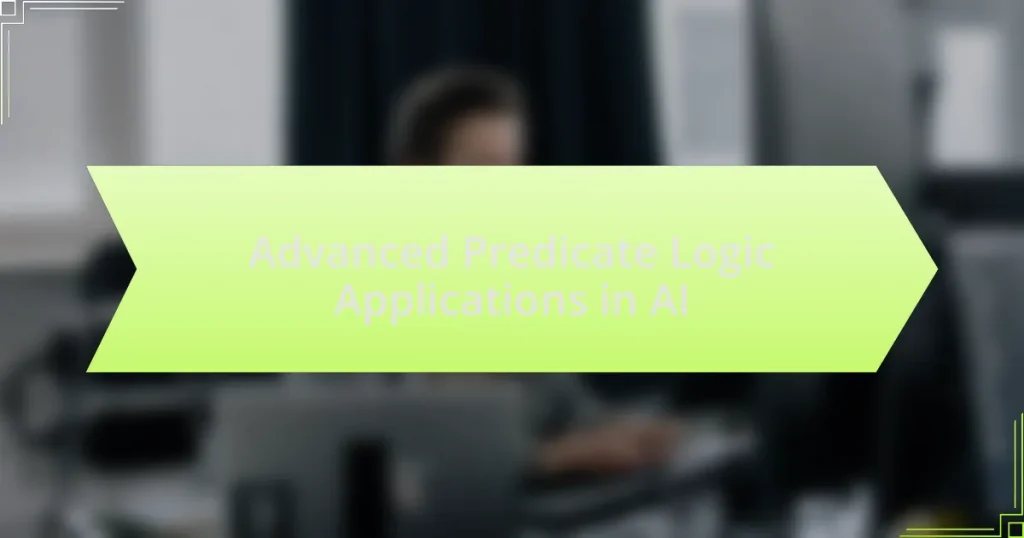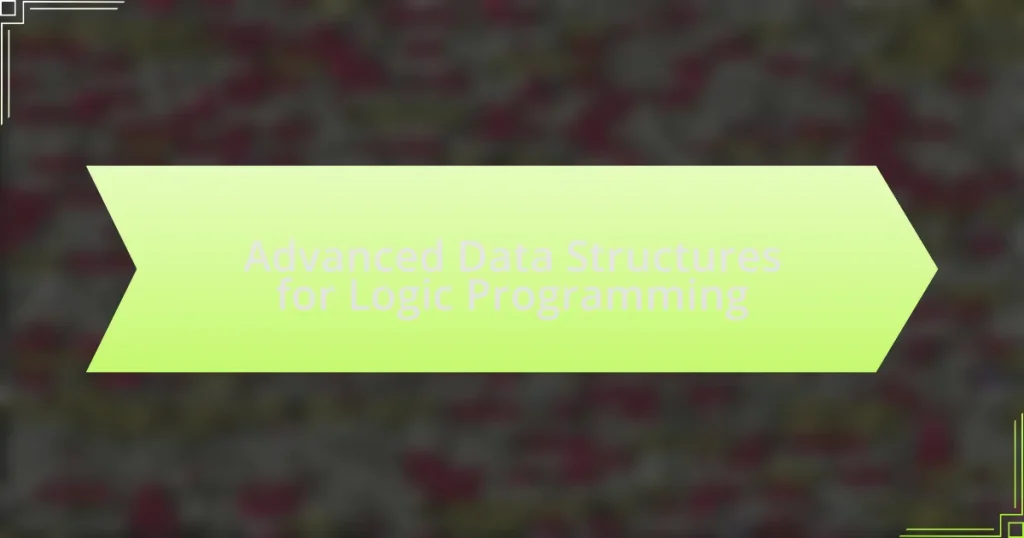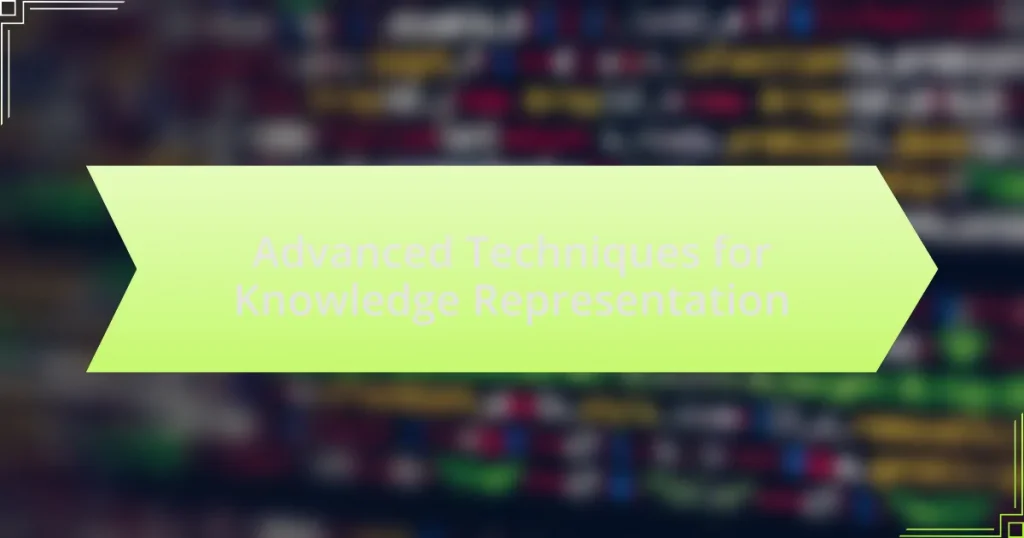Advanced Semantic Web Techniques using Logic Programming involve the application of formal logic to represent and reason about knowledge on the web, utilizing languages such as Prolog and Description Logics. These techniques enhance data interoperability and integration across diverse systems through standardized representations and reasoning capabilities, primarily using ontologies defined in OWL. Key components include reasoning mechanisms, query languages, and logic programming frameworks, which facilitate automated reasoning and knowledge representation. The article also addresses challenges in implementation, practical applications in various domains, and future trends influenced by advancements in artificial intelligence and emerging technologies like blockchain and the Internet of Things.

What are Advanced Semantic Web Techniques using Logic Programming?
Advanced Semantic Web techniques using Logic Programming include the use of formal logic to represent and reason about knowledge on the web. These techniques leverage languages such as Prolog and Description Logics to enable automated reasoning, allowing systems to infer new information from existing data. For instance, the Semantic Web employs ontologies defined in OWL (Web Ontology Language), which are grounded in first-order logic, facilitating complex queries and interoperability among diverse data sources. Research has shown that integrating logic programming with Semantic Web technologies enhances the expressiveness and reasoning capabilities of web applications, as evidenced by studies demonstrating improved data integration and knowledge discovery in domains like biomedical informatics and e-commerce.
How do these techniques enhance data interoperability?
Advanced semantic web techniques using logic programming enhance data interoperability by enabling the integration and sharing of data across diverse systems through standardized representations and reasoning capabilities. These techniques utilize formal logic to define relationships and constraints, allowing different data sources to communicate effectively. For instance, the use of ontologies facilitates a common understanding of data semantics, which improves data exchange and reduces ambiguity. Additionally, logic-based reasoning allows for the inference of new knowledge from existing data, further enriching the interoperability between systems.
What role does logic programming play in achieving interoperability?
Logic programming plays a crucial role in achieving interoperability by providing a formal framework for representing knowledge and reasoning about it across different systems. This framework enables diverse systems to communicate and share information effectively, as logic programming languages, such as Prolog, allow for the specification of rules and relationships that can be universally understood. For instance, the use of ontologies in logic programming facilitates the alignment of data models from various sources, ensuring that they can be integrated and queried seamlessly. This capability is essential in environments where heterogeneous systems need to work together, such as in the Semantic Web, where standardized formats like RDF and OWL are employed to enhance data interoperability.
How do these techniques facilitate data integration across diverse sources?
Advanced Semantic Web techniques using logic programming facilitate data integration across diverse sources by enabling the formal representation of knowledge and relationships among data entities. These techniques utilize ontologies and reasoning mechanisms to harmonize data from heterogeneous sources, allowing for semantic interoperability. For instance, by employing Description Logic, a subset of first-order logic, systems can infer new knowledge from existing data, bridging gaps between different data formats and structures. This approach has been validated in various applications, such as the integration of biomedical data from disparate databases, where logic programming has successfully aligned terminologies and concepts, enhancing data accessibility and usability.
What are the key components of these techniques?
The key components of advanced semantic web techniques using logic programming include ontologies, reasoning mechanisms, and query languages. Ontologies provide a structured framework for representing knowledge, enabling the definition of concepts and relationships within a domain. Reasoning mechanisms, such as description logics and rule-based systems, facilitate the inference of new knowledge from existing data, allowing for enhanced data interoperability and semantic understanding. Query languages, like SPARQL, enable users to retrieve and manipulate data stored in semantic web formats, ensuring efficient access to information. These components work together to create a robust environment for semantic data processing and knowledge representation.
What types of logic programming languages are commonly used?
Commonly used logic programming languages include Prolog, Answer Set Programming (ASP), and Datalog. Prolog, developed in the 1970s, is widely recognized for its use in artificial intelligence and computational linguistics. Answer Set Programming, which emerged in the 1990s, is utilized for knowledge representation and reasoning in non-monotonic logic. Datalog, a subset of Prolog, is often employed in database queries and is known for its efficiency in handling recursive queries. These languages are foundational in the field of logic programming and are integral to advanced semantic web techniques.
How do ontologies contribute to the effectiveness of these techniques?
Ontologies enhance the effectiveness of advanced semantic web techniques using logic programming by providing a structured framework for knowledge representation. This structured framework allows for the clear definition of concepts, relationships, and constraints within a specific domain, facilitating better data interoperability and integration. For instance, ontologies enable reasoning mechanisms to infer new knowledge from existing data, which is crucial in applications such as semantic search and automated reasoning. The use of ontologies in these contexts has been shown to improve the accuracy and relevance of information retrieval, as evidenced by studies demonstrating that systems utilizing ontological frameworks outperform those relying solely on traditional keyword-based approaches.
What challenges are associated with implementing these techniques?
Implementing advanced semantic web techniques using logic programming faces several challenges, including complexity in knowledge representation, scalability issues, and integration with existing systems. The complexity arises from the need to accurately model real-world scenarios using formal logic, which can be difficult and time-consuming. Scalability issues occur as the volume of data increases, making it challenging to maintain performance and efficiency in reasoning processes. Additionally, integrating these techniques with legacy systems often requires significant modifications, which can lead to compatibility problems and increased development costs. These challenges are well-documented in literature, such as the work by Berners-Lee et al. on the Semantic Web, which highlights the difficulties in achieving interoperability and effective data sharing across diverse platforms.
What are the common technical hurdles faced during implementation?
Common technical hurdles faced during the implementation of advanced semantic web techniques using logic programming include data integration challenges, performance issues, and scalability concerns. Data integration challenges arise from the need to harmonize diverse data sources, which often have different formats and semantics, making it difficult to create a unified model. Performance issues can occur due to the computational complexity of reasoning tasks in logic programming, leading to slow query responses. Scalability concerns emerge when the volume of data increases, as existing systems may struggle to maintain efficiency and responsiveness. These hurdles are well-documented in literature, such as the study by Berners-Lee et al. (2001) on the Semantic Web, which highlights the difficulties in data interoperability and processing efficiency.
How can organizations overcome these challenges?
Organizations can overcome challenges in implementing advanced semantic web techniques using logic programming by investing in training and development for their staff. By equipping employees with the necessary skills in logic programming and semantic technologies, organizations can enhance their ability to effectively utilize these advanced techniques. Research indicates that companies that prioritize employee training see a 24% increase in productivity and a 21% increase in profitability, according to a study by the Association for Talent Development. Additionally, fostering collaboration between IT and business units can streamline the integration of these technologies, as highlighted in a report by McKinsey, which found that organizations with cross-functional teams are 30% more likely to achieve their strategic goals.

How do Advanced Semantic Web Techniques using Logic Programming work in practice?
Advanced Semantic Web techniques using Logic Programming work by employing formal logic to represent knowledge and infer new information from existing data. In practice, these techniques utilize languages such as Prolog to create ontologies and rules that define relationships between data entities. For example, a logic-based system can infer that if “All humans are mortal” and “Socrates is a human,” then “Socrates is mortal.” This inference capability allows for enhanced data interoperability and reasoning across diverse datasets on the Semantic Web. The effectiveness of these techniques is evidenced by their application in various domains, such as biomedical research, where they facilitate complex queries and knowledge discovery by integrating heterogeneous data sources.
What are the practical applications of these techniques?
The practical applications of advanced semantic web techniques using logic programming include enhancing data interoperability, improving knowledge representation, and enabling automated reasoning. These techniques facilitate the integration of diverse data sources, allowing systems to understand and process information from various domains seamlessly. For instance, in healthcare, logic programming can be used to create intelligent systems that analyze patient data and provide personalized treatment recommendations based on existing medical knowledge. Additionally, in the field of artificial intelligence, these techniques support the development of more sophisticated natural language processing systems that can infer meaning and context from text, thereby improving user interactions with technology.
How are these techniques utilized in knowledge representation?
Advanced Semantic Web techniques utilize logic programming to represent knowledge through formal structures such as ontologies and rules. These techniques enable the encoding of complex relationships and constraints within a domain, facilitating automated reasoning and inference. For instance, the use of Description Logic allows for the representation of concepts and their interrelations, which supports reasoning tasks like classification and consistency checking. Additionally, rule-based systems, such as those based on Prolog, enable the application of logical rules to derive new knowledge from existing facts, enhancing the system’s ability to answer queries and make decisions based on the represented knowledge.
What role do they play in natural language processing?
In natural language processing, advanced semantic web techniques using logic programming play a crucial role in enhancing the understanding and interpretation of human language. These techniques enable the representation of knowledge in a structured format, allowing for more accurate semantic analysis and reasoning. For instance, logic programming facilitates the development of algorithms that can infer relationships and meanings from text, improving tasks such as information retrieval, sentiment analysis, and machine translation. The use of formal logic in these processes ensures that the systems can handle ambiguity and context, leading to more reliable outcomes in language understanding.
What tools and frameworks support these techniques?
Tools and frameworks that support advanced semantic web techniques using logic programming include Apache Jena, Prolog, and OWL (Web Ontology Language). Apache Jena is a Java framework for building semantic web and linked data applications, providing a programming environment for RDF (Resource Description Framework) and SPARQL (an RDF query language). Prolog is a logic programming language that is widely used in artificial intelligence and computational linguistics, enabling the representation of knowledge and reasoning. OWL is a semantic markup language designed for publishing and sharing ontologies on the web, facilitating the interoperability of data across different systems. These tools and frameworks are essential for implementing logic-based reasoning and knowledge representation in semantic web applications.
What are the most popular logic programming frameworks available?
The most popular logic programming frameworks available include Prolog, SWI-Prolog, and ECLiPSe. Prolog, developed in the 1970s, is widely recognized for its use in artificial intelligence and computational linguistics. SWI-Prolog is an open-source implementation of Prolog that offers extensive libraries and tools for web-based applications, making it suitable for semantic web projects. ECLiPSe is another powerful logic programming system that focuses on constraint logic programming, providing robust support for solving complex combinatorial problems. These frameworks are frequently utilized in advanced semantic web techniques due to their ability to handle logical reasoning and knowledge representation effectively.
How do these tools facilitate the development of semantic web applications?
Tools facilitate the development of semantic web applications by providing frameworks and languages that enable the representation, sharing, and integration of data across different systems. For instance, technologies like RDF (Resource Description Framework) and OWL (Web Ontology Language) allow developers to create structured data models that can be easily understood and processed by machines. These tools support interoperability by ensuring that data from diverse sources can be linked and queried effectively, enhancing the semantic richness of web applications. Furthermore, the use of SPARQL (an RDF query language) enables efficient data retrieval, allowing applications to access and manipulate semantic data seamlessly. This structured approach to data management is essential for building applications that leverage the full potential of the semantic web.
What are the best practices for implementing these techniques?
The best practices for implementing advanced semantic web techniques using logic programming include ensuring a clear understanding of the underlying logic frameworks, utilizing established ontologies for data representation, and employing reasoning engines effectively. A clear understanding of frameworks like Prolog or Datalog allows developers to leverage their strengths in knowledge representation and inference. Utilizing established ontologies, such as OWL (Web Ontology Language), ensures consistency and interoperability across different systems. Employing reasoning engines, such as Pellet or FaCT++, enhances the ability to derive new knowledge from existing data, thereby maximizing the utility of the semantic web. These practices are supported by the widespread adoption of these technologies in successful semantic web projects, demonstrating their effectiveness in real-world applications.
How can organizations ensure successful deployment of these techniques?
Organizations can ensure successful deployment of advanced semantic web techniques using logic programming by implementing a structured approach that includes thorough training, clear objectives, and continuous evaluation. Training staff on the specific logic programming languages and frameworks, such as Prolog or Datalog, enhances their ability to utilize these techniques effectively. Establishing clear objectives aligned with organizational goals ensures that the deployment is purposeful and measurable. Continuous evaluation through performance metrics and feedback loops allows organizations to adapt and refine their strategies, ensuring that the techniques are effectively integrated into existing systems. Research indicates that organizations that invest in training and maintain a focus on measurable outcomes experience a 30% increase in project success rates in technology deployments.
What strategies can be employed to maintain and update systems using these techniques?
To maintain and update systems using advanced semantic web techniques and logic programming, organizations can implement continuous integration and deployment (CI/CD) practices. CI/CD allows for automated testing and deployment of updates, ensuring that systems remain functional and up-to-date with minimal downtime. Additionally, utilizing version control systems, such as Git, enables teams to track changes and collaborate effectively, facilitating easier rollbacks if issues arise. Regularly scheduled maintenance windows can also be established to apply updates and perform system checks without disrupting user experience. These strategies are supported by industry practices that emphasize the importance of automation and collaboration in software development, leading to more resilient and adaptable systems.
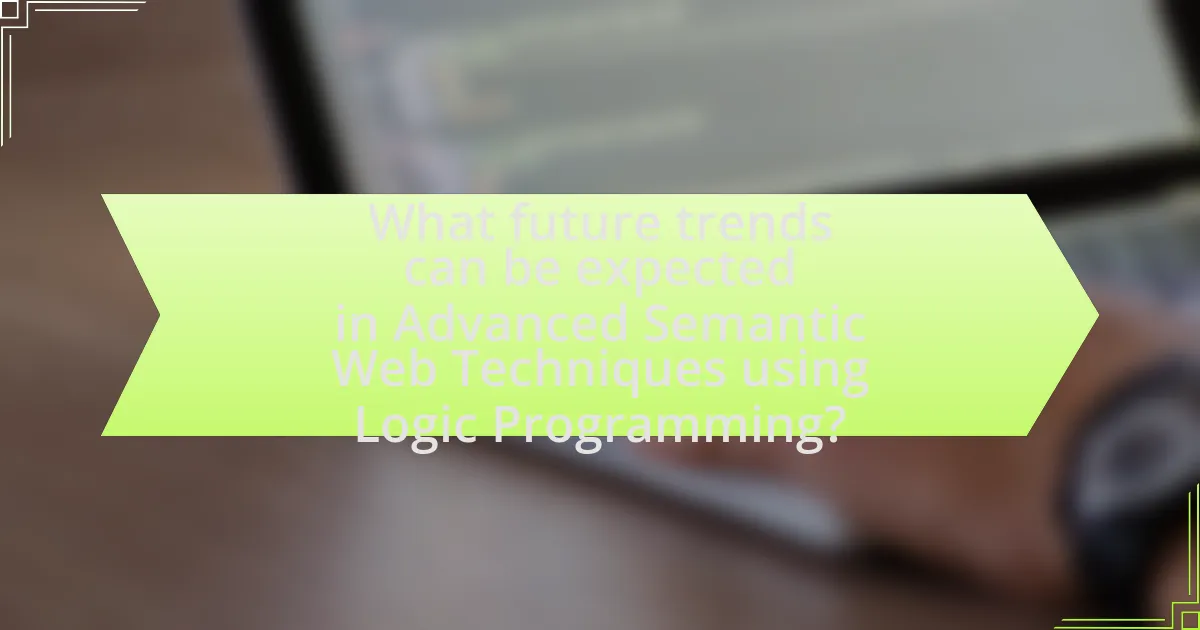
What future trends can be expected in Advanced Semantic Web Techniques using Logic Programming?
Future trends in Advanced Semantic Web Techniques using Logic Programming include increased integration of machine learning with logic-based reasoning, enhancing the ability to infer knowledge from large datasets. This trend is supported by the growing demand for systems that can not only store and retrieve information but also reason about it, as seen in applications like knowledge graphs and intelligent agents. Additionally, the adoption of more expressive logic languages, such as Description Logics and Answer Set Programming, is expected to facilitate richer semantic representations, enabling more complex queries and reasoning tasks. The rise of decentralized web technologies, such as blockchain, may also influence the development of logic programming frameworks that ensure data integrity and provenance in semantic applications.
How is artificial intelligence influencing these techniques?
Artificial intelligence is significantly enhancing advanced semantic web techniques using logic programming by enabling more efficient data processing and improved reasoning capabilities. AI algorithms, particularly those based on machine learning, facilitate the automatic extraction of knowledge from unstructured data, which can then be represented in a structured format suitable for logic programming. For instance, natural language processing models can analyze large datasets to identify relationships and entities, which are essential for creating ontologies and knowledge graphs. This integration allows for more dynamic and adaptable semantic web applications, as evidenced by the increased accuracy in search results and recommendations in platforms utilizing these techniques.
What advancements in AI are likely to enhance logic programming for the semantic web?
Advancements in AI that are likely to enhance logic programming for the semantic web include improved natural language processing (NLP) capabilities, enhanced machine learning algorithms, and the integration of knowledge graphs. Improved NLP allows for better understanding and generation of semantic queries, facilitating more effective logic programming. Enhanced machine learning algorithms enable automated reasoning and inference, which are crucial for logic programming tasks. The integration of knowledge graphs provides structured data that can be leveraged for more accurate and context-aware logic programming, as evidenced by the increasing use of knowledge graphs in AI applications, such as Google’s Knowledge Graph, which enhances search results through semantic understanding.
How can machine learning be integrated with these techniques?
Machine learning can be integrated with advanced semantic web techniques using logic programming by employing machine learning algorithms to enhance the reasoning capabilities of logic-based systems. For instance, machine learning can be used to infer new knowledge from existing data, allowing logic programming frameworks to adapt and improve their performance over time. This integration can be seen in applications such as ontology learning, where machine learning models analyze data to automatically generate or refine ontologies, thus improving semantic understanding. Research has demonstrated that combining machine learning with logic programming can lead to more efficient knowledge representation and retrieval, as evidenced by studies like “Combining Logic Programming and Machine Learning for Knowledge Representation” by Alferes et al., which highlights the effectiveness of this approach in real-world scenarios.
What emerging technologies are shaping the future of these techniques?
Emerging technologies shaping the future of advanced semantic web techniques using logic programming include artificial intelligence, machine learning, and blockchain. Artificial intelligence enhances the ability to process and analyze large datasets, enabling more sophisticated reasoning and inference capabilities in logic programming. Machine learning algorithms improve the adaptability and efficiency of semantic web applications by allowing systems to learn from data patterns and user interactions. Blockchain technology offers decentralized data management, ensuring data integrity and trustworthiness, which is crucial for semantic web applications that rely on accurate information. These technologies collectively drive innovation and improve the effectiveness of logic programming in the semantic web landscape.
How is blockchain technology impacting semantic web applications?
Blockchain technology is enhancing semantic web applications by providing decentralized data management and improving trustworthiness. This decentralization allows for secure data sharing and interoperability among different systems, which is crucial for semantic web applications that rely on linked data. Furthermore, blockchain’s immutable ledger ensures data integrity, enabling semantic web applications to maintain accurate and reliable information. For instance, projects like the Ethereum blockchain support smart contracts that can automate processes in semantic web applications, facilitating more efficient data handling and reducing the need for intermediaries.
What role does the Internet of Things play in the evolution of these techniques?
The Internet of Things (IoT) significantly enhances the evolution of advanced semantic web techniques using logic programming by enabling real-time data collection and integration from diverse sources. This connectivity allows for more dynamic and context-aware applications, as IoT devices generate vast amounts of structured and unstructured data that can be processed using logic programming to derive meaningful insights. For instance, the integration of IoT data with semantic web technologies facilitates improved data interoperability and reasoning capabilities, leading to smarter decision-making processes in various domains such as smart cities and healthcare. Studies have shown that leveraging IoT data in conjunction with semantic web techniques can improve the accuracy of knowledge representation and inference, thereby advancing the overall effectiveness of these techniques.
What practical tips can be applied when exploring these techniques?
When exploring advanced semantic web techniques using logic programming, it is essential to start with a solid understanding of foundational concepts such as ontologies and reasoning mechanisms. Engaging with resources like the W3C’s Semantic Web Standards can provide clarity on best practices and implementation strategies. Additionally, utilizing tools like Prolog or OWL can facilitate hands-on experimentation, allowing for practical application of theoretical knowledge. Research indicates that collaborative projects, such as those found on GitHub, can enhance learning through community support and shared resources. Engaging with these platforms not only fosters skill development but also keeps practitioners updated on emerging trends and techniques in the field.
How can practitioners stay updated with the latest developments in this field?
Practitioners can stay updated with the latest developments in Advanced Semantic Web Techniques using Logic Programming by regularly engaging with academic journals, attending conferences, and participating in online forums. Academic journals such as the Journal of Web Semantics and the Semantic Web Journal publish peer-reviewed articles that highlight recent research and advancements in the field. Conferences like the International Semantic Web Conference (ISWC) provide opportunities for networking and learning about cutting-edge techniques directly from experts. Additionally, online forums and communities, such as those on ResearchGate or LinkedIn groups focused on semantic web technologies, facilitate discussions and knowledge sharing among practitioners. These methods ensure that professionals remain informed about the latest trends, tools, and methodologies in the rapidly evolving landscape of semantic web technologies.
What resources are available for learning more about these techniques?
Resources for learning about advanced semantic web techniques using logic programming include academic textbooks, online courses, and research papers. Notable textbooks such as “Semantic Web for the Working Ontologist” by Dean Allemang and James Hendler provide foundational knowledge and practical applications. Online platforms like Coursera and edX offer courses on semantic web technologies, often featuring modules on logic programming. Additionally, research papers from conferences like the International Semantic Web Conference (ISWC) and journals such as the Journal of Web Semantics present cutting-edge developments and case studies in the field. These resources collectively support a comprehensive understanding of the techniques involved in advanced semantic web applications.
